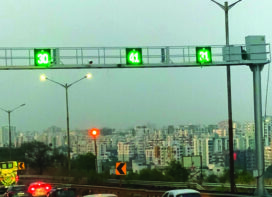 Cities all over the world are struggling with congestion. Traffic data analytics can be the key to solving mobility problems.
Cities all over the world are struggling with congestion. Traffic data analytics can be the key to solving mobility problems.
Bogota is the most congested city in the world according to the Global Traffic Scorecard that was recently published by Inrix. On average, drivers lose 191 hours per year in the Colombian capital due to traffic jams. Boston is ranked as the most congested city in the U.S. with more than six days per driver and year lost. In Europe, drivers have to be patient too: Rome, Paris and London also made it into the top-ten.
Congested roads are a constant headache for cities all over the globe. They are facing greater challenges than ever before. On the one hand, cities want to be liveable for people, on the other, they have to meet a wide range of mobility demands. creating sustainable transport systems. It is the key to solving urban mobility problems.
Traffic data can not only help identify bottlenecks and congestion hot spots in cities. Using big data in transportation also assists urban planners in creating sustainable transport systems. It is the key to solving urban mobility problems.
 Data analytics enables traffic planners to make profound decisions in urban design. Software tools help them analyze and combine a wide variety of data, e.g. inner-city movements and parking data, weather and event data. Problems can thus be identified, and appropriate measures developed.
Data analytics enables traffic planners to make profound decisions in urban design. Software tools help them analyze and combine a wide variety of data, e.g. inner-city movements and parking data, weather and event data. Problems can thus be identified, and appropriate measures developed.
Processed big data can be applied for multiple applications, e.g, for the creation of transport models, or toll data and truckrelated restrictions. Also sensor data harvested from smartphones and apps, such as motion and usage data, are a valuable source of information. These records help us analyze how fast someone is travelling or which route or mode of transport was taken.
City planners and engineers get valuable assistance in addressing urgent and important issues regarding the mobility of the future. For example: how can new micro-mobility services be effectively integrated into the existing mobility offering? How many vehicles are needed to profitably operate a new bike sharing, e-scooter or on-demand shuttle service?
Big data offers a holistic view
The visualization of data makes all relevant mobility parameters more transparent. Due to the increasing number of new micromobility services, urban mobility is becoming more diverse every day. Be it the occupancy of parking spaces, availability and movement patterns of rental bikes and e-scooter fleets, the current traffic situation, positions of the public transport fleet, traffic behavior under different weather conditions and at different times of day, etc. A lot of parameters that have to be taken into consideration for the development of sustainable urban concepts.
 Data analytics for the implementation of regulatory measures
Data analytics for the implementation of regulatory measures
Data analytics can support policymakers in the transport sector to directly test and evaluate the implementation of regulatory measures: From transit and parking restriction to the introduction of low emission zones.
Data analytics for demand planning
When planning new on-demand services, it is important to reliably determine in advance the demand for vehicles under various conditions. How many vehicles will be needed in the city area A in the morning? What happens if it rains? The combination of historical data and artificial intelligence methods helps analyze areas with oversupply or higher demand and thus plan ahead.
Kristina Stifter from PTV group writes about
international best practices that make cities
liveable and offer intelligent mobility solutions.
 TrafficInfraTech Magazine Linking People Places & Progress
TrafficInfraTech Magazine Linking People Places & Progress


